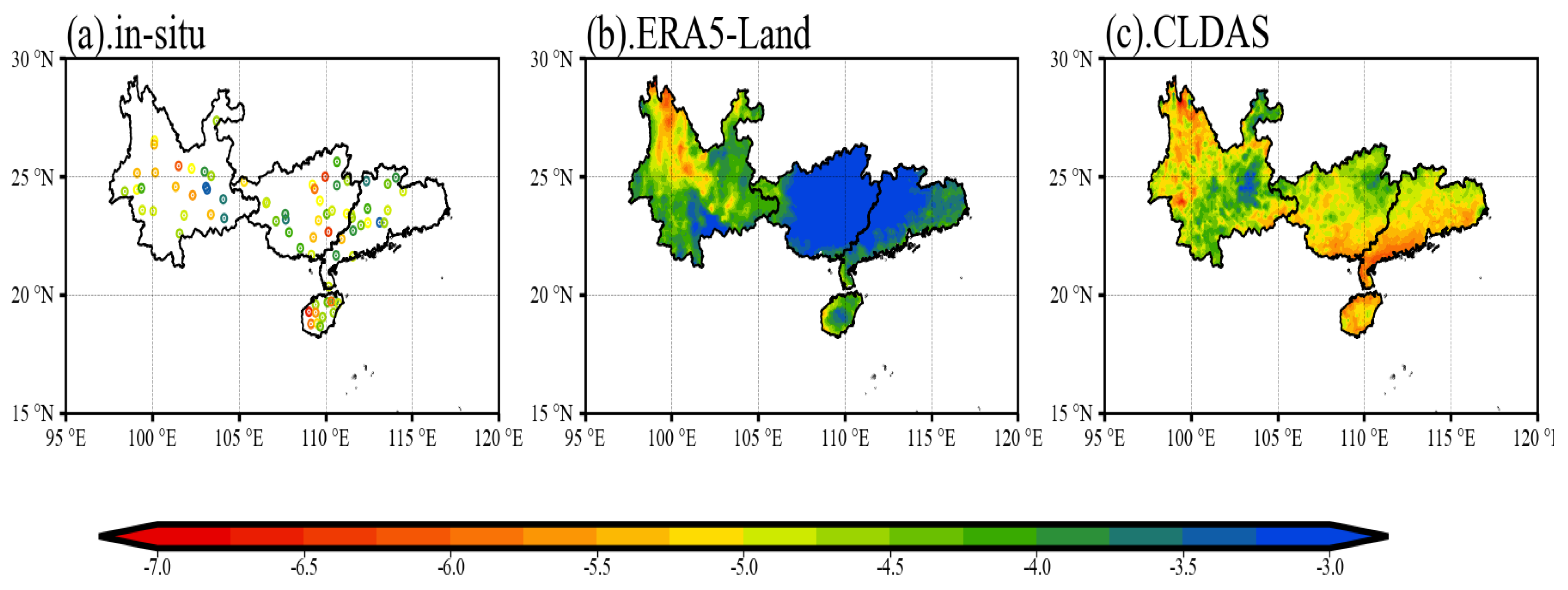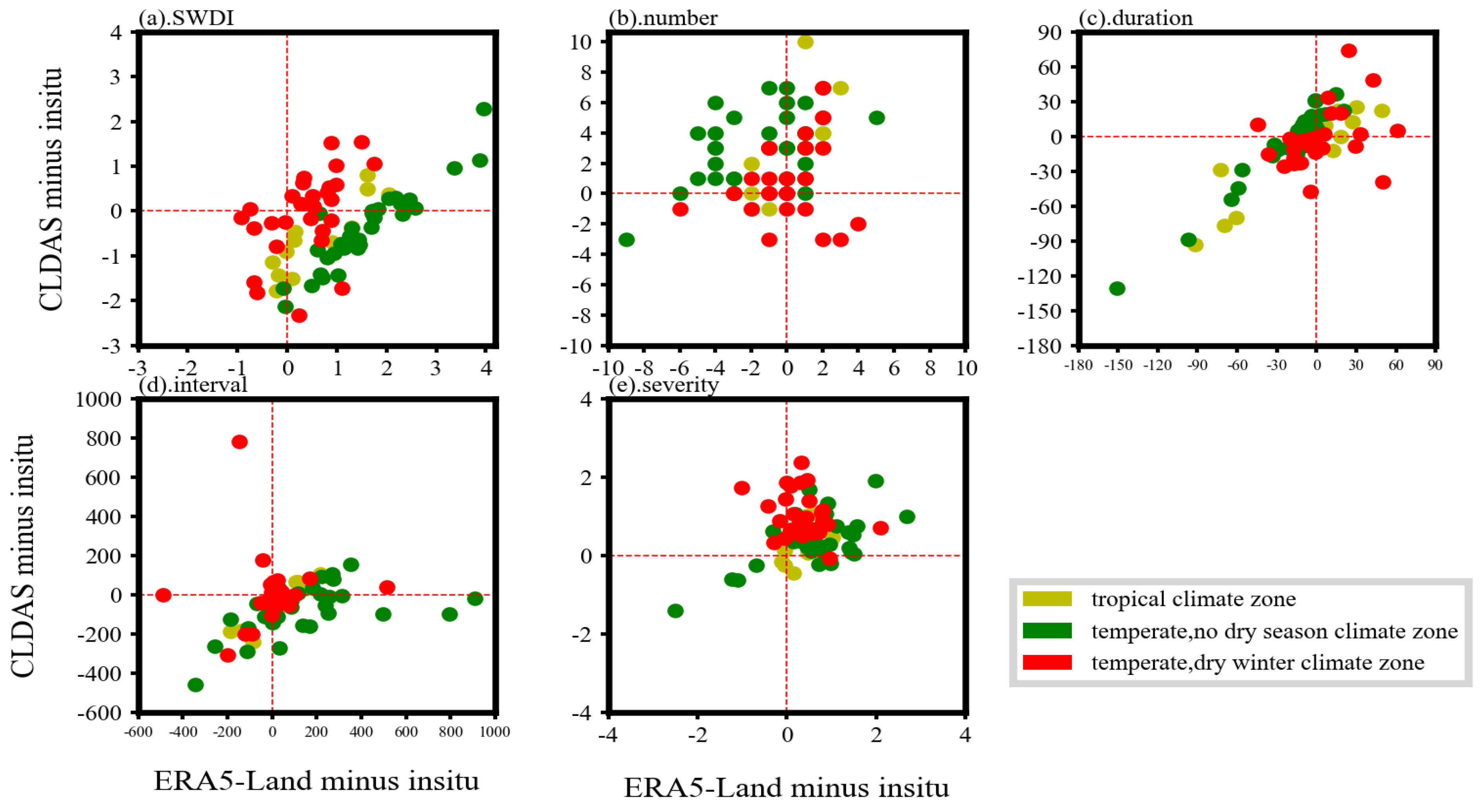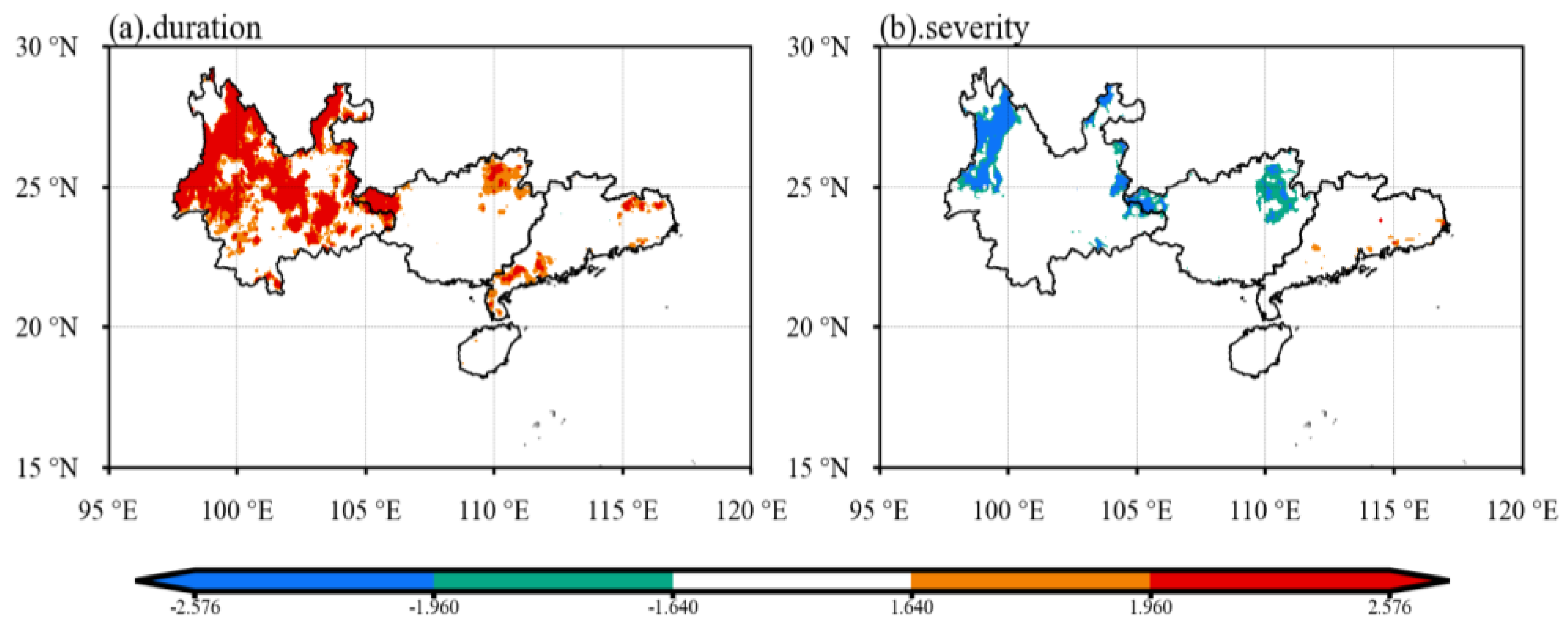Assessment of Agricultural Drought Based on Reanalysis Soil Moisture in Southern China
Abstract
:1. Introduction
2. Materials and Methods
2.1. Study Area
2.2. Data
2.2.1. In Situ Data
2.2.2. CLDAS Data
2.2.3. ERA5-Land Data
2.3. Methods
2.3.1. Soil Water Deficit Index (SWDI)
2.3.2. Atmospheric Water Deficit Index (AWD)
2.3.3. Drought Characterization and Trend Detection
2.3.4. Evaluation Indices
3. Results and Discussion
3.1. Evaluation of CLDAS and ERA5-Land Soil Moisture
3.1.1. Statistical Characteristics of Soil Moisture
3.1.2. Spatial Pattern of Soil Moisture
3.1.3. Evaluation of CLDAS and ERA5-Land Soil Moisture
3.2. Evaluation of CLDAS_SWDI, ERA5-Land_SWDI, and Agricultural Drought Characteristics
3.2.1. Spatial and Temporal Pattern of SWDI
3.2.2. Evaluation of CLDAS_SWDI and ERA5-Land_SWDI
3.2.3. Comparison of CLDAS_SWDI and ERA5-Land_SWDI
3.2.4. Comparison of CLDAS and ERA5-Land SWDIs and Drought Characteristics
3.3. Agricultural Drought in the Four Southern Provinces from 1981 to 2020
3.3.1. Spatial Pattern of Average SWDI and Tendency of SWDI
3.3.2. Spatial Pattern of Agricultural Drought Characteristics
3.3.3. Tendency of the Agricultural Drought Characteristics
3.3.4. Comparison between ERA5-Land_SWDI and AWD
4. Conclusions
- (1)
- ERA5-Land and CLDAS overestimated SM in each climate zone. However, ERA5-Land_SWDI had a wet bias, while CLDAS_SWDI had a dry bias. ERA5-Land and CLDAS had a similar performance in representing agricultural drought characteristics, though some differences existed and ERA5-Land was better than CLDAS in terms of drought numbers. However, CLDAS has limited data availability, and ERA5-Land is recommended for long-term studies.
- (2)
- During the period 1981–2020, the SWDI was relatively larger in most areas of the temperate, no dry season climate zone, while the SWDI was relatively small in most areas of Yunnan and coastal areas, indicating that the degree of drought was relatively severe. The number, interval, and duration of drought events had a relatively similar spatial distribution in the different decades during the past 40 years. In addition, droughts from 2001 to 2010 were more serious than those from the other three decades.
- (3)
- The drought duration showed a significant upward trend in Yunnan, parts of Guangxi, and parts of the southern coast of Guangdong. At the same time, the drought severity showed an upward trend in areas of northwest and east Yunnan, and northeast Guangxi.
- (4)
- By using total evapotranspiration instead of potential evapotranspiration, a higher correlation between agricultural drought and meteorological drought was witnessed, which indicates that it is necessary to use the SWDI to capture agricultural drought.
Supplementary Materials
Author Contributions
Funding
Data Availability Statement
Acknowledgments
Conflicts of Interest
References
- Nicolai-Shaw, N.; Zscheischler, J.; Hirschi, M.; Gudmundsson, L.; Seneviratne, S.I. A drought event composite analysis using satellite remote-sensing based soil moisture. Remote Sens. Environ. 2017, 203, 216–225. [Google Scholar] [CrossRef]
- Tian, Y.; Xu, Y.P.; Wang, G.Q. Agricultural drought prediction using climate indices based on Support Vector Regression in Xiangjiang River basin. Sci. Total Environ. 2018, 622–623, 710–720. [Google Scholar] [CrossRef] [PubMed]
- Zhong, R.D.; Chen, X.H.; Lai, C.G.; Wang, Z.L.; Lian, Y.Q.; Yu, H.J.; Wu, X.Q. Drought monitoring utility of satellite-based precipitation products across mainland China. J. Hydrol. 2019, 568, 343–359. [Google Scholar] [CrossRef]
- Wang, A.H.; Lattenmaier, D.P.; Sheffield, J. Soil Moisture Drought in China, 1950–2006. J. Clim. 2011, 24, 3257–3271. [Google Scholar] [CrossRef]
- Zhang, X.J.; Tang, Q.H.; Liu, X.C.; Leng, G.Y.; Li, Z. Soil Moisture Drought Monitoring and Forecasting Using Satellite and Climate Model Data over Southwestern China. J. Hydrol. 2017, 18, 5–23. [Google Scholar] [CrossRef]
- Panu, U.S.; Sharma, T.C. Challenges in drought research: Some perspectives and future directions. Hydrol. Sci. 2002, 47, 19–30. [Google Scholar] [CrossRef] [Green Version]
- Narasimhan, B.; Srinivasan, R. Development and evaluation of soil moisture deficit index (SMDI) and evapotranspiration deficit index (ETDI) for agricultural drought monitoring. Agric. For. Meteorol. 2005, 133, 69–88. [Google Scholar]
- Rouse, J.W., Jr.; Deeding, D.W.; Haas, R.H.; Schell, J.A. Monitoring Vegetation Systems in the Great Plains with Erts. NASA Cent. Aerosp. Inform. (CASI) 1974, 1, 309–317. [Google Scholar]
- Keshavarz, M.R.; Vazifedoust, M.; Alizadeh, A. Drought monitoring using a Soil Wetness Deficit Index (SWDI) derived from MODIS satellite data. Agric. Water Manag. 2014, 132, 37–45. [Google Scholar] [CrossRef]
- Kogan, F.N. Droughts of the Late 1980s in the United States as Derived from NOAA Polar-Orbiting Satellite Data. Bull. Am. Meteorol. Soc. 1995, 76, 655–668. [Google Scholar] [CrossRef] [Green Version]
- Kogan, F.N. Application of vegetation index and brightness temperature for drought detection. Adv. Space Res. 1995, 15, 91–100. [Google Scholar] [CrossRef]
- Martínez-Fernández, J.; González-Zamora, A.; Sánchez, N.; Gumuzzio, A. A soil water based index as a suitable agricultural drought indicator. J. Hydrol. 2015, 522, 265–273. [Google Scholar] [CrossRef]
- Shangguan, W.; Dai, Y.J.; Duan, Q.Y.; Liu, B.Y.; Yuan, H. A global soil data set for earth system modeling. J. Adv. Model. Earth Syst. 2013, 6, 249–263. [Google Scholar] [CrossRef]
- Aditi, G.; Andres, R.M.; Ana, C.D. The physiology of plant responses to drought. Am. Assoc. Adv. Sci. 2020, 368, 266–269. [Google Scholar]
- Lian, X.; Piao, S.; Li, L.Z.; Li, Y.; Huntingford, C.; Ciais, P.; Cescatti, A.; Janssens, I.A.; Peñuelas, J.; Buermann, W.; et al. Summer soil drying exacerbated by earlier spring greening of northern vegetation. Sci. Adv. 2020, 6, eaax0255. [Google Scholar] [CrossRef] [Green Version]
- Crow, W.T.; Cosh, M.H.; Berg, A.A.; Loew, A.; Mohanty, B.P.; Panciera, R.; Ryu, D.; De Rosnay, P.; Walker, J.P. Upscaling Sparse Ground-based Soil Moisture Observations for the Validation of Coarse-resolution Satellite Soil Moisture Products. Rev. Geophys. 2012, 50, 2011RG000372. [Google Scholar] [CrossRef] [Green Version]
- Liu, D.; Mishra, A.K.; Yu, Z.B. Evaluating uncertainties in multi-layer soil moisture estimation with support vector machines and ensemble Kalman filtering. J. Hydrol. 2016, 538, 243–255. [Google Scholar] [CrossRef] [Green Version]
- Albergel, C.; Rosnay, P.; Gruhier, C.; Muńoz-Sabater, J.; Hasenauer, S.; Isaksen, L.; Kerr, Y.; Wagner, W. Evaluation of Remotely Sensed and Modelled Soil Moisture Products Using Global Ground-based in Situ Observations. Remote Sens. Environ. 2012, 118, 215–226. [Google Scholar] [CrossRef]
- Holgate, C.M.; De Jeu, R.A.M.; Van Dijk, A.I.J.M.; Liu, Y.Y.; Renzullo, L.J.; Dharssi, I.; Parinussa, R.M.; Van Der Schalie, R.; Gevaert, A.; Walker, J.; et al. Comparison of Remotely Sensed and Modelled Soil Moisture Data Sets across Australia. Remote Sens. Environ. 2016, 186, 479–500. [Google Scholar] [CrossRef]
- Beck, H.E.; Pan, M.; Miralles, D.G.; Reichle, R.H.; Dorigo, W.A.; Hahn, S.; Sheffield, J.; Karthikeyan, L.; Balsamo, G.; Parinussa, R.M.; et al. Evaluation of 18 satellite- and model-based soil moisture products using in situ measurements from 826 sensors. Hydrol. Earth Syst. Sci. 2021, 25, 17–40. [Google Scholar] [CrossRef]
- Han, S.; Shi, C.; Jiang, L.; Zhang, T.; Liang, X.; Jiang, Z.; Xu, B.; Li, X.; Zhu, Z.; Lin, H. The simulation and evaluation of soil moisture based on CLDAS. J. Appl. Meteorol. Sci. 2017, 28, 369–378. [Google Scholar]
- Zhang, R.Q.; Li, L.; Zhang, Y.; Huang, F.N.; Li, J.D.; Liu, W.; Mao, T.N.; Xiong, Z.L.; Shangguan, W. Assessment of Agricultural Drought using Soil Water Deficit Index based on ERA5-Land soil moisture data in four southern provinces of China. Agriculture 2021, 11, 411. [Google Scholar] [CrossRef]
- Zhu, Q.; Luo, Y.; Xu, Y.-P.; Tian, Y.; Yang, T. Satellite Soil Moisture for Agricultural Drought Monitoring: Assessment of SMAP-Derived Soil Water Deficit Index in Xiang River Basin, China. Remote Sens. 2019, 11, 362. [Google Scholar] [CrossRef] [Green Version]
- Lu, L.H.; Zhang, D.E. The temporal and spatial variation characteristics of annual precipitation in China and its relationship with the East Asian summer monsoon. Quat. Stud. 2013, 33, 11. [Google Scholar]
- Rubel, F.; Kottek, M. Observed and projected climate shifts 1901–2100 depicted by world maps of the Köppen-Geiger climate classification. Meteorol. Z. 2010, 19, 135–141. [Google Scholar]
- Shi, C.X.; Xie, Z.H.; Qian, H.; Liang, M.L.; Yang, X.C. China land soil moisture EnKF data assimilation based on satellite remote sensing data. Sci. China Earth Sci. 2011, 54, 1430–1440. [Google Scholar] [CrossRef]
- Muñoz-Sabater, J.; Dutra, E.; Agustí-Panareda, A.; Albergel, C.; Arduini, G.; Balsamo, G.; Boussetta, S.; Choulga, M.; Harrigan, S.; Hersbach, H.; et al. ERA5-Land: A state-of-the-art global reanalysis dataset for land applications. Earth Syst. Sci. Data 2021, 13, 4349–4383. [Google Scholar] [CrossRef]
- Pablos, M.; González-Zamora, Á.; Sánchez, N.; Martínez-Fernández, J. Assessment of SMADI and SWDI agricultural drought indices using remotely sensed root zone soil moisture. Int. Assoc. Hydrol. Sci. 2018, 380, 55–66. [Google Scholar] [CrossRef] [Green Version]
- Miriam, P.; Martínez-Fernández, J.; Sánchez, N.; González-Zamora, Á. Temporal and Spatial Comparison of Agricultural Drought Indices from Moderate Resolution Satellite Soil Moisture Data over Northwest Spain. Remote Sens. 2017, 9, 1168–1195. [Google Scholar]
- Mishra, A.; Vu, T.; Veettil, A.V.; Entekhabi, D. Drought monitoring with soil moisture active passive (SMAP) measurements. J. Hydrol. 2017, 552, 620–632. [Google Scholar] [CrossRef]
- Torres, G.M.; Lollato, R.P.; Ochsner, T.E. Comparison of Drought Probability Assessments Based on Atmospheric Water Deficit and Soil Water Deficit. Agron. J. 2013, 105, 428–436. [Google Scholar] [CrossRef]
- Dorigo, W.; Chung, D.; Wagner, W.; De Jeu, R.; Parinussa, R.; Liu, Y.; Fernández-Prieto, D. Evaluating global trends (1988–2010) in harmonized multi-satellite surface soil moisture. Geophys. Res. Lett. 2012, 39, L18405. [Google Scholar] [CrossRef] [Green Version]
- Hu, Y.M.; Liang, Z.M.; Liu, Y.W.; Zeng, X.F.; Wang, D. Uncertainty assessment of estimation of hydrological design values. Stoch. Environ. Res. Risk Assess. 2015, 29, 501–511. [Google Scholar] [CrossRef]
- Le, M.H.; Kim, H.; Moon, H.; Zhang, R.; Lakshmi, V.; Nguyen, L.B. Assessment of drought conditions over Vietnam using standardized precipitation evapotranspiration index, MERRA-2 reanalysis, and dynamic land cover. J. Hydrol. Reg. Stud. 2020, 32, 100767. [Google Scholar] [CrossRef]
- Tosunoglu, F.; Kisi, O. Trend analysis of maximum hydrologic drought variables using Mann–Kendall and Şen’s innovative trend method. River Res. Appl. 2017, 33, 597–610. [Google Scholar] [CrossRef]
- Mann, H.B. Nonparametric tests again trend. Econometrica 1945, 13, 245–259. [Google Scholar] [CrossRef]
- Zohaib, M.; Choi, M.; Kim, H. Evaluating the patterns of spatiotemporal trends of root zone soil moisture in major climate regions in east Asia. J. Geophys. Res. 2017, 122, 7705–7722. [Google Scholar] [CrossRef]
- Wu, Z.; Feng, H.; He, H.; Zhou, J.; Zhang, Y. Evaluation of soil moisture climatology and anomaly components derived from ERA5-land and GLDAS-2.1 in China. Water Resour. Manag. 2020, 35, 629–643. [Google Scholar] [CrossRef]
- Kim, H.; Wigneron, J.P.; Kumar, S.; Dong, J.; Wagner, W.; Cosh, M.H.; Bosch, D.D.; Collins, H.C.; Starks, P.J.; Starks, P.J.; et al. Global scale error assessments of soil moisture estimates from microwave-based active and passive satellites and land surface models over forest and mixed irrigated/dryland agriculture regions. Remote Sens. Environ. 2020, 251, 112052. [Google Scholar] [CrossRef]
- Dai, M.; Huang, S.Z.; Huang, Q.; Leng, G.Y.; Guo, Y.; Wang, L.; Fang, W.; Li, P.; Zheng, X.D. Assessing agricultural drought risk and its dynamic evolution characteristics. Agric. Water Manag. 2020, 231, 106003–106015. [Google Scholar] [CrossRef]
- Wang, H.J. The weakening of the Asian monsoon circulation after the end of 1970’s. Adv. Atmos. Sci. 2001, 18, 376–386. [Google Scholar]
- Ding, Y.H.; Si, D.; Liu, Y.J.; Wang, Z.Y.; Li, Y.; Zhao, L.; Song, Y.F. On the characteristics, driving forces and inter-decadal variability of the East Asian summer monsoon. Chin. J. Atmos. Sci. 2018, 42, 533–558. (In Chinese) [Google Scholar]
- Niu, J. Precipitation in the Pearl River basin, South China: Scaling, regional patterns, and influence of large-scale climate anomalies. Stoch. Environ. Res. Risk Assess. 2013, 27, 1253–1268. [Google Scholar] [CrossRef]








| Climate Zone | Data | Mean | Min | Max | Median | Standard Deviation | Number of Observations (Grids) |
|---|---|---|---|---|---|---|---|
| tropical | In situ | 0.2666 | 0.0501 | 0.641 | 0.268 | 0.058 | 15 |
| ERA5-Land | 0.3628 | 0.0592 | 0.517 | 0.371 | 0.066 | 245 | |
| CLDAS | 0.3254 | 0.1613 | 0.552 | 0.326 | 0.034 | 245 | |
| temperate, no dry season | In situ | 0.3222 | 0.0588 | 0.614 | 0.319 | 0.041 | 34 |
| ERA5-Land | 0.4067 | 0.0784 | 0.520 | 0.418 | 0.050 | 2957 | |
| CLDAS | 0.3435 | 0.2158 | 0.585 | 0.343 | 0.029 | 2957 | |
| temperate, dry winter | In situ | 0.3039 | 0.084 | 0.5317 | 0.299 | 0.049 | 28 |
| ERA5-Land | 0.3850 | 0.086 | 0.5185 | 0.397 | 0.061 | 4145 | |
| CLDAS | 0.3269 | 0.198 | 0.5955 | 0.332 | 0.034 | 4145 |
Publisher’s Note: MDPI stays neutral with regard to jurisdictional claims in published maps and institutional affiliations. |
© 2022 by the authors. Licensee MDPI, Basel, Switzerland. This article is an open access article distributed under the terms and conditions of the Creative Commons Attribution (CC BY) license (https://creativecommons.org/licenses/by/4.0/).
Share and Cite
Shangguan, W.; Zhang, R.; Li, L.; Zhang, S.; Zhang, Y.; Huang, F.; Li, J.; Liu, W. Assessment of Agricultural Drought Based on Reanalysis Soil Moisture in Southern China. Land 2022, 11, 502. https://doi.org/10.3390/land11040502
Shangguan W, Zhang R, Li L, Zhang S, Zhang Y, Huang F, Li J, Liu W. Assessment of Agricultural Drought Based on Reanalysis Soil Moisture in Southern China. Land. 2022; 11(4):502. https://doi.org/10.3390/land11040502
Chicago/Turabian StyleShangguan, Wei, Ruqing Zhang, Lu Li, Shulei Zhang, Ye Zhang, Feini Huang, Jianduo Li, and Wei Liu. 2022. "Assessment of Agricultural Drought Based on Reanalysis Soil Moisture in Southern China" Land 11, no. 4: 502. https://doi.org/10.3390/land11040502






